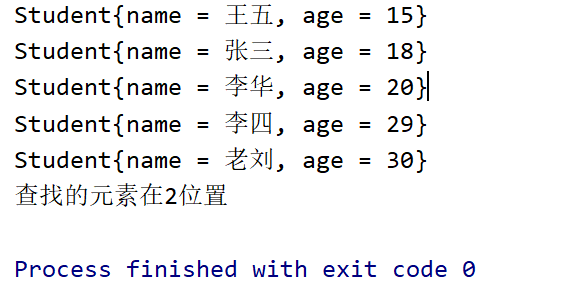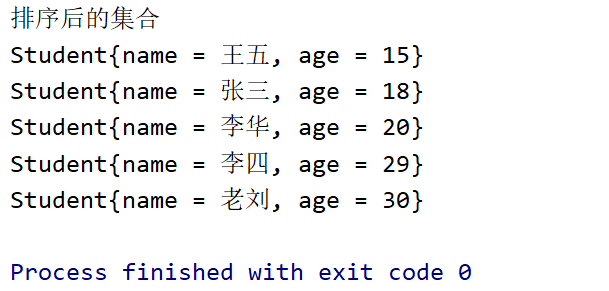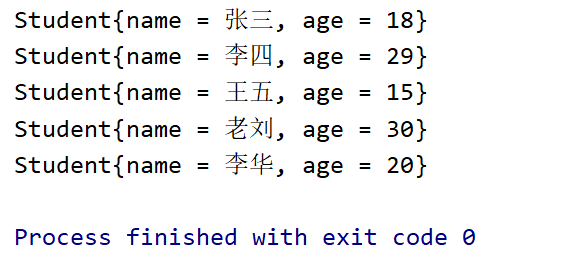Collection工具类
Collections工具类,里面的方法全是静态方法.
1. 二分查找List
语法:
static <T> int binarySearch(List<? extends Comparable<? super T>> list, T key) :使用二叉搜索算法搜索指定对象的指定列表。
举个例子:
1 public class Test {
2 public static void main(String[] args) {
3 //生成无参集合
4 ArrayList<Student> list=new ArrayList<>();
5 //添加元素
6 list.add(new Student("张三",18));
7 list.add(new Student("李四",29));
8 list.add(new Student("王五",15));
9 list.add(new Student("老刘",30));
10 list.add(new Student("李华",20));
11 //排序后的集合结果
12 Collections.sort(list,new Comparator<Student>() {
13 //使用匿名接口实现类的方式
14 @Override
15 public int compare(Student o1, Student o2) {
16 return o1.getAge() - o2.getAge();
17 }
18 });
19 for (Student student:list) {
20 System.out.println(student);
21 }
22 //使用二分查找
23 int index = Collections.binarySearch(list, new Student("李华", 20), new Comparator<Student>() {
24 //使用匿名接口实现类的方式
25 @Override
26 public int compare(Student o1, Student o2) {
27 return o1.getAge() - o2.getAge();
28 }
29 });
30 System.out.println("查找的元素在"+index+"位置");
31 }
32 }
33 class Student{
34 private String name;
35 private int age;
36
37
38 public Student() {
39 }
40
41 public Student(String name, int age) {
42 this.name = name;
43 this.age = age;
44 }
45
46 public String getName() {
47 return name;
48 }
49
50 public void setName(String name) {
51 this.name = name;
52 }
53
54 public int getAge() {
55 return age;
56 }
57
58 public void setAge(int age) {
59 this.age = age;
60 }
61
62 public String toString() {
63 return "Student{name = " + name + ", age = " + age + "}";
64 }
65 }
效果展示:

2. 倒置集合
语法:
static void reverse(List<?> list):反转指定列表中元素的顺序。
举个例子:
1 public class Test {
2 public static void main(String[] args) {
3 //生成无参集合
4 ArrayList<Student> list=new ArrayList<>();
5 //添加元素
6 list.add(new Student("张三",18));
7 list.add(new Student("李四",29));
8 list.add(new Student("王五",15));
9 list.add(new Student("老刘",30));
10 list.add(new Student("李华",20));
11 System.out.println("反转前的集合");
12 for (Student student:list) {
13 System.out.println(student);
14 }
15 System.out.println("反转后的集合");
16 Collections.reverse(list);
17 for (Student student:list) {
18 System.out.println(student);
19 }
20 }
21 }
22 class Student{
23 private String name;
24 private int age;
25
26
27 public Student() {
28 }
29
30 public Student(String name, int age) {
31 this.name = name;
32 this.age = age;
33 }
34
35 public String getName() {
36 return name;
37 }
38
39 public void setName(String name) {
40 this.name = name;
41 }
42
43 public int getAge() {
44 return age;
45 }
46
47 public void setAge(int age) {
48 this.age = age;
49 }
50
51 public String toString() {
52 return "Student{name = " + name + ", age = " + age + "}";
53 }
54 }
效果展示:

3. 洗牌功能
语法:
static void shuffle(List<?> list) :使用默认的随机源随机排列指定的列表。
举个例子:
1 public class Test {
2 public static void main(String[] args) {
3 //生成无参集合
4 ArrayList<Student> list=new ArrayList<>();
5 //添加元素
6 list.add(new Student("张三",18));
7 list.add(new Student("李四",29));
8 list.add(new Student("王五",15));
9 list.add(new Student("老刘",30));
10 list.add(new Student("李华",20));
11 System.out.println("洗牌前的集合");
12 for (Student student:list) {
13 System.out.println(student);
14 }
15 System.out.println("洗牌后的集合");
16 Collections.shuffle(list);
17 for (Student student:list) {
18 System.out.println(student);
19 }
20 }
21 }
22 class Student{
23 private String name;
24 private int age;
25
26
27 public Student() {
28 }
29
30 public Student(String name, int age) {
31 this.name = name;
32 this.age = age;
33 }
34
35 public String getName() {
36 return name;
37 }
38
39 public void setName(String name) {
40 this.name = name;
41 }
42
43 public int getAge() {
44 return age;
45 }
46
47 public void setAge(int age) {
48 this.age = age;
49 }
50
51 public String toString() {
52 return "Student{name = " + name + ", age = " + age + "}";
53 }
54 }
效果展示:

4. 排序
语法:
static <T> void sort(List<T> list, Comparator<? super T> c) :根据指定的比较器引起的顺序对指定的列表进行排序
举个例子:
1 public class Test {
2 public static void main(String[] args) {
3 //生成无参集合
4 ArrayList<Student> list=new ArrayList<>();
5 //添加元素
6 list.add(new Student("张三",18));
7 list.add(new Student("李四",29));
8 list.add(new Student("王五",15));
9 list.add(new Student("老刘",30));
10 list.add(new Student("李华",20));
11 System.out.println("排序后的集合");
12 Collections.sort(list, new Comparator<Student>() {
13 @Override
14 public int compare(Student o1, Student o2) {
15 return o1.getAge()-o2.getAge();
16 }
17 });
18 for (Student student:list) {
19 System.out.println(student);
20 }
21
22 }
23 }
24 class Student{
25 private String name;
26 private int age;
27
28
29 public Student() {
30 }
31
32 public Student(String name, int age) {
33 this.name = name;
34 this.age = age;
35 }
36
37 public String getName() {
38 return name;
39 }
40
41 public void setName(String name) {
42 this.name = name;
43 }
44
45 public int getAge() {
46 return age;
47 }
48
49 public void setAge(int age) {
50 this.age = age;
51 }
52
53 public String toString() {
54 return "Student{name = " + name + ", age = " + age + "}";
55 }
56 }
效果展示:

5.
在未来多线程操作的时候,线程安全就会显得十分重要.
语法:
static <T> List<T> synchronizedList(List<T> list) :返回由指定列表支持的同步(线程安全)列表。
举个例子:
1 public class Test {
2 public static void main(String[] args) {
3 //生成无参集合
4 ArrayList<Student> list=new ArrayList<>();
5 //添加元素
6 list.add(new Student("张三",18));
7 list.add(new Student("李四",29));
8 list.add(new Student("王五",15));
9 list.add(new Student("老刘",30));
10 list.add(new Student("李华",20));
11 12 List<Student> students = Collections.synchronizedList(list);
13 14 for (Student student:students) {
15 System.out.println(student);
16 }
17
18 }
19 }
20 class Student{
21 private String name;
22 private int age;
23
24
25 public Student() {
26 }
27
28 public Student(String name, int age) {
29 this.name = name;
30 this.age = age;
31 }
32
33 public String getName() {
34 return name;
35 }
36
37 public void setName(String name) {
38 this.name = name;
39 }
40
41 public int getAge() {
42 return age;
43 }
44
45 public void setAge(int age) {
46 this.age = age;
47 }
48
49 public String toString() {
50 return "Student{name = " + name + ", age = " + age + "}";
51 }
52 }
效果展示:

多线程无法直接展示出来,需要学习到线程时才能完美的展示效果。